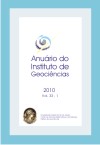Litter fall, litter storage and litter water retention in Eucalyptus urophylla and Eucalyptus grandis hybrids plantation: the Paraíba do Sul river middle valley
DOI:
https://doi.org/10.11137/2010_2_66-73Abstract
Eucalyptus patches are spreading rapidly through middle Paraíba do Sul river valley and environmental effects of this activity are still ambivalent and poorly documented (Vianna et al., 2007). This study aims to evaluate the litter production and litter storage on slopes in Eucalyptus and verify its water retention capacity, to support understanding of the hydrological responses to rainfall inputs. This study aims to evaluate the litter production and litter storage of Eucalyptus. Study site is located at a headwater basin in Sesmarias river basin covered by Eucalyptus grandis x urophyla, 3 x 2 meters spaced (1666 trees. ha-1) planted in April 2004. Litter was collected in four different positions using 0.5 quadracts to litter production measurement, and 0.25 m quadracts to litter storage measurement. Samples were dried, weighted, separated in fractions (leaves, branches, grass, roots + fine material) and had the fractions weighted. Litter fall showed an increase with decreasing rainfall, and the litter fall was higher in the divisor (10.2 Mg.ha-1) than in the slope (6.6 Mg.ha-1). Litter storage presents an increase trend, with annual accumulation of 2,2 Mg.ha-1 and it is composed largely by leafs. Water retention capacity is 235%, which is close to values that are found in the Tropical rainforest (200% - 259%).Downloads
Download data is not yet available.
Downloads
Published
2010-12-01
How to Cite
Melos, A. R. de, Sato, A. M. and Coelho Netto, A. L. (2010) “Litter fall, litter storage and litter water retention in Eucalyptus urophylla and Eucalyptus grandis hybrids plantation: the Paraíba do Sul river middle valley”, Anuário do Instituto de Geociências. Rio de Janeiro, BR, 33(2), pp. 66–73. doi: 10.11137/2010_2_66-73.
Issue
Section
não definida
License
This journal is licensed under a Creative Commons — Attribution 4.0 International — CC BY 4.0, which permits use, distribution and reproduction in any medium, provided the original work is properly cited.















